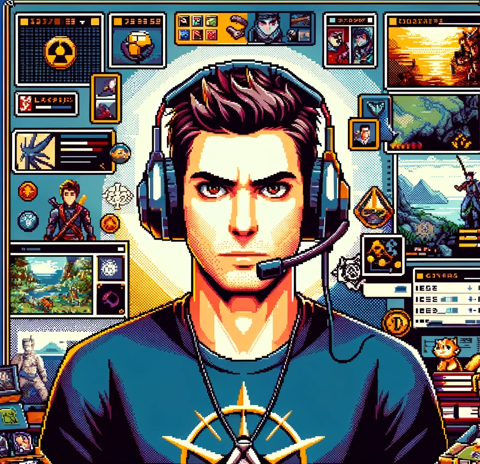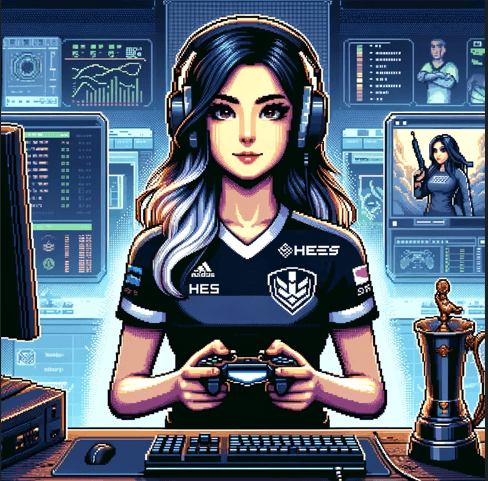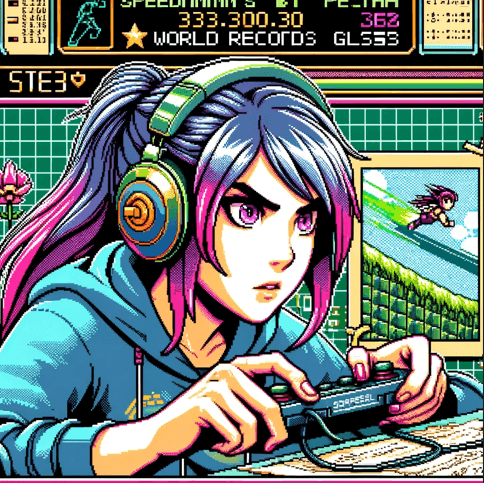 Dragon Is Dead from TeamSuneat and published by PM Studios mixes roguelite action and platforming. I loved the Diablo‑style loot loops and the interconnected Metroidvania map design, which keeps exploration feeling fresh. Many players praise its replay value and fast pacing, noting how each run feels both familiar and surprising. One fan called it a “perfect blend of Metroidvania and Diablo loot,” and it’s easy to see why. The indie studio TeamSuneat uses Unity to power fluid 2D action, giving you smooth character movement and crisp visuals that never skip a beat.
Dragon Is Dead from TeamSuneat and published by PM Studios mixes roguelite action and platforming. I loved the Diablo‑style loot loops and the interconnected Metroidvania map design, which keeps exploration feeling fresh. Many players praise its replay value and fast pacing, noting how each run feels both familiar and surprising. One fan called it a “perfect blend of Metroidvania and Diablo loot,” and it’s easy to see why. The indie studio TeamSuneat uses Unity to power fluid 2D action, giving you smooth character movement and crisp visuals that never skip a beat.
 I agree. The game boasts dozens of hidden rune stones tucked into secret alcoves and destructible walls. I tracked every collectible in Cliffshire’s burial grounds, marking each one on my mini‑map as I went. Finding all legendary weapons felt deeply rewarding—especially when a rare drop finally appeared. PM Studios often localizes Japanese indie hits with care, making sure flavor text and character names shine. Fans said the gear‑crafting feels deep and varied, with “tons of customization fun,” even if RNG sometimes throws repeat drops. I see room to tweak drop tables slightly—more balance would help completionists hit that 100% mark without frustration.
I agree. The game boasts dozens of hidden rune stones tucked into secret alcoves and destructible walls. I tracked every collectible in Cliffshire’s burial grounds, marking each one on my mini‑map as I went. Finding all legendary weapons felt deeply rewarding—especially when a rare drop finally appeared. PM Studios often localizes Japanese indie hits with care, making sure flavor text and character names shine. Fans said the gear‑crafting feels deep and varied, with “tons of customization fun,” even if RNG sometimes throws repeat drops. I see room to tweak drop tables slightly—more balance would help completionists hit that 100% mark without frustration.
 The controls feel tight and precise. You dodge enemy attacks, shatter their patterns, then counterattack with satisfying impact. I map my favorite skills to the controller triggers for quick access, which feels intuitive in the heat of battle. Developers said they wanted “pattern‑breaking combat,” and that vision shows: elite mobs test your timing, yet combat flows faster than Souls‑likes. I often compare it to Rogue Legacy’s skill resets, but Dragon Is Dead adds multi‑layered stages and vertical movement that shake up each room in clever ways.
The controls feel tight and precise. You dodge enemy attacks, shatter their patterns, then counterattack with satisfying impact. I map my favorite skills to the controller triggers for quick access, which feels intuitive in the heat of battle. Developers said they wanted “pattern‑breaking combat,” and that vision shows: elite mobs test your timing, yet combat flows faster than Souls‑likes. I often compare it to Rogue Legacy’s skill resets, but Dragon Is Dead adds multi‑layered stages and vertical movement that shake up each room in clever ways.
 As a speedrunner, those roguelite loops matter a lot. You keep gear and rune progress on each run, making later clears blisteringly fast. I clocked a complete run in thirty minutes, leveraging relics that boost movement and double dodge frames. Speedrunners will love the room for time saves and routing, with shortcuts hidden under platforms. It feels reminiscent of Dead Cells’ dash‑style combat but with enough unique quirks to stand on its own.
As a speedrunner, those roguelite loops matter a lot. You keep gear and rune progress on each run, making later clears blisteringly fast. I clocked a complete run in thirty minutes, leveraging relics that boost movement and double dodge frames. Speedrunners will love the room for time saves and routing, with shortcuts hidden under platforms. It feels reminiscent of Dead Cells’ dash‑style combat but with enough unique quirks to stand on its own.
 The story hooks me immediately. Guernian’s fall and the spread of Corruption feel urgent, with lore snippets in dev posts that sent chills down my spine. TeamSuneat drew heavily from Norse myths when crafting Guernian’s backstory, giving each rune boss a mythic aura. Dialogue remains short and tight, and world‑building hides in item descriptions—though some fans have asked for more cutscenes. I think brief lore logs fit the pace perfectly, adding depth without interrupting the action.
The story hooks me immediately. Guernian’s fall and the spread of Corruption feel urgent, with lore snippets in dev posts that sent chills down my spine. TeamSuneat drew heavily from Norse myths when crafting Guernian’s backstory, giving each rune boss a mythic aura. Dialogue remains short and tight, and world‑building hides in item descriptions—though some fans have asked for more cutscenes. I think brief lore logs fit the pace perfectly, adding depth without interrupting the action.
 The narrative appears through scrolls and NPC chats scattered in hidden rooms. I hunted every bit of lore—uncovering the twist about Black Dawn’s true plan felt earned after memorizing boss patterns. A Steam user wanted more voice lines, and I agree: optional audio logs could deepen the world without slowing down speedruns. They’d be easy to skip if you just want to dash through.
The narrative appears through scrolls and NPC chats scattered in hidden rooms. I hunted every bit of lore—uncovering the twist about Black Dawn’s true plan felt earned after memorizing boss patterns. A Steam user wanted more voice lines, and I agree: optional audio logs could deepen the world without slowing down speedruns. They’d be easy to skip if you just want to dash through.
 Plot pacing stays consistent throughout. You clear an area, return stronger, and uncover a new secret—echoing classic roguelites like Hades. Each rune boss ties directly into the story, revealing just enough to keep you curious. I saw an interview where TeamSuneat said they wanted “player‑driven revelations,” and that design shines through; the pacing never drags, even after multiple runs.
Plot pacing stays consistent throughout. You clear an area, return stronger, and uncover a new secret—echoing classic roguelites like Hades. Each rune boss ties directly into the story, revealing just enough to keep you curious. I saw an interview where TeamSuneat said they wanted “player‑driven revelations,” and that design shines through; the pacing never drags, even after multiple runs.
 I appreciate how story beats never block runs—you get minimal dialogue before the next fight, so the momentum stays high. Speedrunners can skip lore entirely, yet secrets still reward explorers who take the time. It’s clever design that respects both playstyles without compromise.
I appreciate how story beats never block runs—you get minimal dialogue before the next fight, so the momentum stays high. Speedrunners can skip lore entirely, yet secrets still reward explorers who take the time. It’s clever design that respects both playstyles without compromise.
 Visually, Dragon Is Dead shines with sharp pixel art. TeamSuneat chose a dark palette for Corruption zones, making light areas pop with warm tones. Fans praise the fluid animation of boss attacks, and Unity handles particle effects smoothly—even during frantic dodge windows. I explored every stained‑glass window and carved pillar, spotting reused tiles only sparingly. The boss sprite work feels detailed, and one user called the art direction “gorgeous.” It holds up beautifully on a 4K monitor.
Visually, Dragon Is Dead shines with sharp pixel art. TeamSuneat chose a dark palette for Corruption zones, making light areas pop with warm tones. Fans praise the fluid animation of boss attacks, and Unity handles particle effects smoothly—even during frantic dodge windows. I explored every stained‑glass window and carved pillar, spotting reused tiles only sparingly. The boss sprite work feels detailed, and one user called the art direction “gorgeous.” It holds up beautifully on a 4K monitor.
 I tested performance on both PC and Switch. Most zones run at a solid sixty frames per second, though some late levels dip near forty on Switch. Developers plan a patch to smooth those dips. Overall, the art balance between clarity and detail works well for tight dodge windows, and I love watching color flashes for invincibility frames. They stand out, helping me time dashes perfectly.
I tested performance on both PC and Switch. Most zones run at a solid sixty frames per second, though some late levels dip near forty on Switch. Developers plan a patch to smooth those dips. Overall, the art balance between clarity and detail works well for tight dodge windows, and I love watching color flashes for invincibility frames. They stand out, helping me time dashes perfectly.
 The soundtrack blends orchestral swells and driving synth, intensifying boss encounters. The opening theme builds tension fast, and credits list composer Aki Chen—whose work I hope to hear in DLC. I looped the Cliffshire town theme while hunting loot; its hopeful melody contrasts nicely with choral Corruption drones. No voice acting yet, and while some fans miss NPC chatter, I enjoy the silent role‑play that lets you imagine your successor’s voice.
The soundtrack blends orchestral swells and driving synth, intensifying boss encounters. The opening theme builds tension fast, and credits list composer Aki Chen—whose work I hope to hear in DLC. I looped the Cliffshire town theme while hunting loot; its hopeful melody contrasts nicely with choral Corruption drones. No voice acting yet, and while some fans miss NPC chatter, I enjoy the silent role‑play that lets you imagine your successor’s voice.
 Sound effects pop on impact: swords clang, runes hum, and the dodge cue feels crisp—vital for speedruns. Developers used FMOD for audio mixing, which I read about in a dev blog, and the careful layering helps players learn enemy tells. Boss roars warn of attack patterns, making audio feedback crucial for mastering timing.
Sound effects pop on impact: swords clang, runes hum, and the dodge cue feels crisp—vital for speedruns. Developers used FMOD for audio mixing, which I read about in a dev blog, and the careful layering helps players learn enemy tells. Boss roars warn of attack patterns, making audio feedback crucial for mastering timing.
 Characters feel iconic. Your Successor avatar is blank enough to role‑play, while the three gods tie directly into your skill trees. Fans praise Ashuran’s flame skills for their epic visuals, and I love the elemental synergy. I read NPC backstories in hidden codex entries—they reveal minor cultures and hint at tragic pasts. I’d like more diversity in side‑quest roles, but I still collected every lore fragment.
Characters feel iconic. Your Successor avatar is blank enough to role‑play, while the three gods tie directly into your skill trees. Fans praise Ashuran’s flame skills for their epic visuals, and I love the elemental synergy. I read NPC backstories in hidden codex entries—they reveal minor cultures and hint at tragic pasts. I’d like more diversity in side‑quest roles, but I still collected every lore fragment.
 I analyzed each skill tree, Light, Fire, and Water, each pushing different playstyles. You can mix and match runes to create unique builds. I built a glass‑cannon water mage, though some talents need specific legendary elements, which can gate certain builds. Swapping runes quickly felt seamless, letting me blitz rooms with Water Dash and Fire Aura. I even found a skip rout
I analyzed each skill tree, Light, Fire, and Water, each pushing different playstyles. You can mix and match runes to create unique builds. I built a glass‑cannon water mage, though some talents need specific legendary elements, which can gate certain builds. Swapping runes quickly felt seamless, letting me blitz rooms with Water Dash and Fire Aura. I even found a skip rout
 The game balances challenge well. Early fights teach dodge timing gently, and boss spikes feel fair once you learn patterns. One Steam user called the stunlock mechanic frustrating, but in my runs it was rare. Side floors ramp difficulty smoothly, letting me farm rune drops without massive walls. RNG sometimes meant repeated bosses, and I’d love a “pity RNG” system or guaranteed drop boosts to keep grinding feeling fun.
The game balances challenge well. Early fights teach dodge timing gently, and boss spikes feel fair once you learn patterns. One Steam user called the stunlock mechanic frustrating, but in my runs it was rare. Side floors ramp difficulty smoothly, letting me farm rune drops without massive walls. RNG sometimes meant repeated bosses, and I’d love a “pity RNG” system or guaranteed drop boosts to keep grinding feeling fun.
 Combat difficulty spikes after the midgame boss, with auto‑homing elites and damaging auras. Solid relic synergy eases the burden, but I’d welcome a mid‑run gear swap option to smooth out those walls. Some rooms can break speedruns, yet smart routing and platform skips keep times stable.
Combat difficulty spikes after the midgame boss, with auto‑homing elites and damaging auras. Solid relic synergy eases the burden, but I’d welcome a mid‑run gear swap option to smooth out those walls. Some rooms can break speedruns, yet smart routing and platform skips keep times stable.
 Replay value excels: roguelite loops always feel fresh, thanks to procedural maps and randomized loot. I replay for better gear, new boss secrets, and unique rune combos. I unlocked every blessing and experimented with tank, glass‑cannon, and caster builds. Though many speedrunners avoid casters, I found a water mage build that chews through bosses—proof that rune crafting drives deep replay.
Replay value excels: roguelite loops always feel fresh, thanks to procedural maps and randomized loot. I replay for better gear, new boss secrets, and unique rune combos. I unlocked every blessing and experimented with tank, glass‑cannon, and caster builds. Though many speedrunners avoid casters, I found a water mage build that chews through bosses—proof that rune crafting drives deep replay.
 I keep chasing new strats with every patch, thinking of it like Celeste’s assist mode updates: small tweaks that preserve speedrun‑friendliness while adding depth. Dragon Is Dead stands out in roguelite platformers for blending tight combat, deep loot, and engaging lore. It’s a must‑play for fans of Diablo, Dead Cells, and Hollow Knight.
I keep chasing new strats with every patch, thinking of it like Celeste’s assist mode updates: small tweaks that preserve speedrun‑friendliness while adding depth. Dragon Is Dead stands out in roguelite platformers for blending tight combat, deep loot, and engaging lore. It’s a must‑play for fans of Diablo, Dead Cells, and Hollow Knight.
 Final Thoughts. Dragon Is Dead stands out in roguelite platformers. The blend of tight combat, deep loot, and lore shines. It matches fans of Diablo, Dead Cells, and Hollow Knight.
Final Thoughts. Dragon Is Dead stands out in roguelite platformers. The blend of tight combat, deep loot, and lore shines. It matches fans of Diablo, Dead Cells, and Hollow Knight.
 If you love Dragon Is Dead’s thrilling roguelite action, dive into Rogue Legacy 2 for rewarding meta‑progression and randomized levels, or Hades for its fast‑paced combat and rich mythology. Dead Cells offers fluid 2D battles and endless runs, while Salt and Sanctuary delivers challenging Souls‑style platforming. For a heartfelt narrative and pixel‑art charm, try Children of Morta. Each of these titles features tight combat, deep customization, and addictive replay loops that keep you coming back.
If you love Dragon Is Dead’s thrilling roguelite action, dive into Rogue Legacy 2 for rewarding meta‑progression and randomized levels, or Hades for its fast‑paced combat and rich mythology. Dead Cells offers fluid 2D battles and endless runs, while Salt and Sanctuary delivers challenging Souls‑style platforming. For a heartfelt narrative and pixel‑art charm, try Children of Morta. Each of these titles features tight combat, deep customization, and addictive replay loops that keep you coming back.
